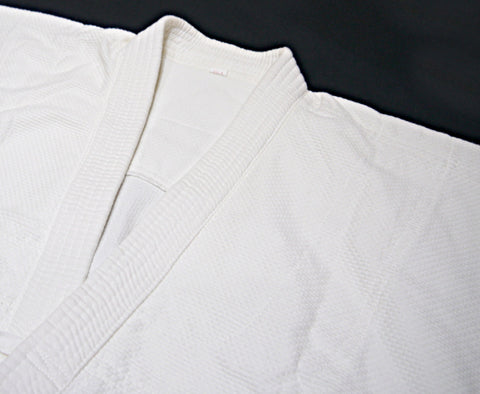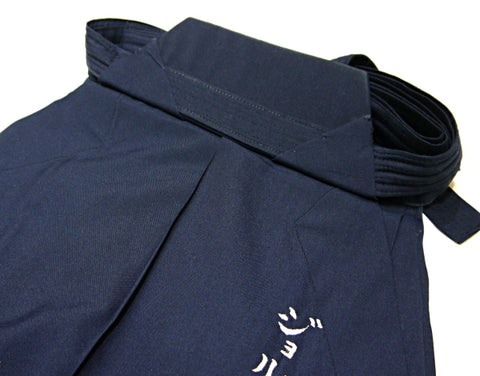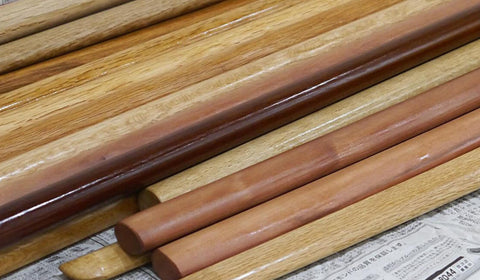-
Japanese Wooden Weapons Craftsmanship, the Beginning of the End | In addition to the structural crisis affecting the industry, in 2019, the closure of one of the largest Japanese workshops, Horinouchi, then, in 2020, the covid crisis have for consequences a drastic increase in prices and production times, and mid-term, a probable disappearance of the manufacture of wooden weapons in Japan. To learn more, you can read our article detailing the situation and the measures taken to help this industry. -
Review Reward Campaign | Leave a comment on your recent purchase and receive a 5% discount.
Take care of your equipment
All your need to know to keep your stuff as long as possible
A well maintained equipment is an equipment that lasts a long time! Washing instructions are never indicated on traditional Japanese equipments so we will report here the advice of our craftsmen.
Contents
AikiDogi
Japanese cotton is an excellent material, it is very solid, shrinks very little, however it needs some care. Note that even during cold washing, cotton will shrink slightly, between 2% and 3%, depending on the model (indicated on each product page).

Seido Dogi after 3 years of intensive use
- Wash at 40 ° C maximum in machine.
- Use a detergent that is suitable for washing cotton, with whitening agent. If possible, use a liquid form (badly diluted washing powder tends to cling to the Dogi).
- Do not mix with colors. (Never wash with colored belts as they tend to bleed).
- Beware of using too much detergent! Rinsing should be perfect, especially if you do not wear your Dogi within a few days after laundry (remaining traces of detergent greatly favor the growth of molds).
- No dryer! Heat and frictions greatly damage cotton.
- Hang in a dry environment. Be careful not to dry under direct exposure to the sun!
Adding bleach is not recommended, however, it is better to add a cupful of bleach in the washing machine rather than increasing the washing temperature.
It is best to cold-wash your Dogi after each class rather than washing once a week at high temperature or with an excess of detergent.
Our tip: wash your Dogi just after the class, with little or no detergent in cold water (it is very fast, and with the exception of heavy models, the Dogi will be dry on the next day). Then every 4 or 5 classes, wash with detergent at 40 ° C.
Dry your Dogi on a hanger immediately after washing. If you tap it with your hand to give it its original form, most models will not require ironing.
If you follow the instructions above, you will keep your Dogi for a long time. At the training rate of 2 hours per day, our Dogi remain in excellent condition for over a year. At a rate of 2 to 3 classes per week, our Dogi can last for more than 5 years without any problem.
If you do not intend to wear your Dogi for several weeks, we recommend folding it along the seams and wrap it in a cloth bag.
Hakama
The Hakama With Synthetic Dye
Tetron (Polyester / Rayon), Cashmere (100% Polyester) and Linen (polyester linen) models are maintained similarly. Colors do not bleed in the wash, folds are tight and will not fade easily, they do not shrink. The black / navy cotton model does not fade and shrinks very little (about 1 cm on length), however, the folds hold less well than the synthetic. You must therefore be careful and secure them with clothespins or better, with a needle and thread.
You may think that washing a Hakama is complicated and that it is better to put it to the cleaners? If your laundry knows how to deal with this type of clothing, why not! But it is not that complicated. In addition, Hakama is usually washed less often than Dogi, every 3 months or so.

Seido Hakama after 3 years of intensive use
- Cold hand wash (30°C).
- Use small quantities of a special detergent for hand washing or for synthetic fabrics.
- Hakama do not bleed, but as a precaution, do not mix with colors or white.
- Rinse thoroughly to prevent detergent residues that promotes the growth of mold.
- No dryer! Heat damage synthetic fabrics!
-
Hang to dry in a dry environment, securing the folds with clothespins.
> Do not dry in direct sunlight, which would affect the color of your Hakama! - Never use bleach!
Even though in Japan, all cleaners know how to wash Hakama without a problem, we tend to do it ourselves. We pour lukewarm water in a sink with a little detergent. Once diluted well, we place the folded Hakama for a few hours in the sink, shaking it occasionally. Then, we rinse using warm water two or three times to avoid detergent residues on the fabric, and hang it unfolded on a hanger, holding pleats with fixing pegs.
The trick: use a washing net of the size of the Hakama to prevent it from unfolding in the sink.
The synthetic Hakama are not pre-washed. You can wear them without washing first, but be careful at the first wash. We recommend simply rinsing with clean cold water two or three times to get rid of any residual chemical fixative.
Aizome Cotton Hakama
Maintenance of Aizome Hakama is much more complex than maintaining synthetic dye Hakama. In addition, most cleaners refuse this type of Hakama because it rubs off tremendously. However, the clothing on which the Hakama might have rubbed off can be washed easily (same as your sink after washing your Hakama).
Before first use:
We strongly recommend you to fix the dye. To do this, soak your Hakama in vinegar and salt water overnight, and repeat the process 3, 4, or 5 times (the water will turn yellow and not blue, don't worry, it is due to the chemical reaction between the natural Aizome dye and vinegar, which is evidence that the dye is actual traditional Japanese Aizome!). The result will not be perfect, your Hakama will continue to fade, but significantly less.
Frequent washings:
Aizome dye is difficult to maintain, but it also has many advantages. It captures odors, it possesses antiseptic, anti-mildew, and insect repellent properties (it also has softening properties for the cotton). Therefore, an Aizome Hakama can be used for a long time without washing if it is properly dried after each use. You find more information about the "traditional Aizome dyeing process" on our blog.
- Cold hand-washing (30°C max.)
-
Use a detergent suitable for washing cotton fabrics and natural dyes. Use very little detergent.
> Detergents for traditional jeans work fine (jeans were originally dyed with indigo from India). - Wash it on its own, with no other clothing!
- No dryer ! Heat and frictions damage cotton. Aizome dust can also damage your dryer.
-
Hang to dry in a dry environment. Be careful not to dry in direct sunlight!
> Beware of drops, they will stain your floor.
Of course, never bleach, it would stain the tissue forever.
As for the Dogi, if you do not use your Hakama over a long period of time, it is best to store it in a cloth bag (you can use the Seido bag that comes with all our Hakama ;) ).
Obi (Belt)
In the West, a common misconception is that one does not wash belts. This is wrong! A belt can be washed as well as the Dogi or Hakama. The same advice should be followed as for the Dogi. Note however that the belts shrink about 10 cm after washing.
- Machine washing at 40°C maximum.
- Use detergent suitable for washing cotton. Use liquid detergent if possible (badly diluted washing powder tends to cling to the obi).
- Do not mix with colors.
- Beware, colored belts bleed!
Wooden Weapons
Varnished and unvarnished weapons have to be distinguished. The former require very little maintenance while the latter will need much more care.
Contrary to what happens in many shops, wooden weapons should be stored horizontally! Humidity and temperature vary significantly depending on the height and the weapons stored vertically will tend to bend quickly (even if they are varnished).
They can be stored on a stand (Katanakake) or simply in their bag, on the floor (be careful not to store your weapons in a room that is too wet or too dry).
Unvarnished Weapons:
Just before shipment, our unvarnished weapons are oiled several times (3 or 4 times) to fill out the timber ports and allow immediate use upon receipt.
Approximately once a month, wipe your weapon with a clean cloth with tight fibers, then generously lubricate the wood with camellia oil or any other oil designed for cleaning wood. You can lay 2 or 3 coats of oil until the wood can no longer absorb it if it hasn't been oiled for a long time. Feel free to use your hands. The drying can take a few hours, and if you would like to increase protection, you can add a layer of wax (we recommend beeswax).
Alternatively, once every 6 to 12 months, immerse your weapons in an oil bath if you have this type of equipment at your disposal.
Gradually, the color of your weapons will change, touch will change and wood density will increase. You will truly feel that wood is a living material!

Weapons are oiled at our shop before shipping
Varnished Weapons:
Varnished weapons can withstand many years of practice without maintenance.
When the varnish starts to fade or when the weapon has taken a few hits, it is possible to sand it, then oil it, which will turn it into an unvarnished weapon.
Be careful though, cheap weapons manufactured in China or Taiwan have a varnish of relatively poor quality, and it is possible that the weapon becomes unusable if the wood begins to produce splinters. This is a problem that you will not have with our weapons!